Related Research Articles

Enrico Fermi was an Italian and later naturalized American physicist, renowned for being the creator of the world's first nuclear reactor, the Chicago Pile-1, and a member of the Manhattan Project. He has been called the "architect of the nuclear age" and the "architect of the atomic bomb". He was one of very few physicists to excel in both theoretical physics and experimental physics. Fermi was awarded the 1938 Nobel Prize in Physics for his work on induced radioactivity by neutron bombardment and for the discovery of transuranium elements. With his colleagues, Fermi filed several patents related to the use of nuclear power, all of which were taken over by the US government. He made significant contributions to the development of statistical mechanics, quantum theory, and nuclear and particle physics.

Fermium is a synthetic chemical element; it has symbol Fm and atomic number 100. It is an actinide and the heaviest element that can be formed by neutron bombardment of lighter elements, and hence the last element that can be prepared in macroscopic quantities, although pure fermium metal has not yet been prepared. A total of 20 isotopes are known, with 257Fm being the longest-lived with a half-life of 100.5 days.

Lise Meitner was an Austrian-Swedish physicist who was one of those responsible for the discovery of the element protactinium and nuclear fission. While working on radioactivity at the Kaiser Wilhelm Institute of Chemistry in Berlin, she discovered the radioactive isotope protactinium-231 in 1917. In 1938, Meitner and her nephew, the physicist Otto Robert Frisch, discovered nuclear fission. She was praised by Albert Einstein as the "German Marie Curie".

Neptunium is a chemical element; it has symbol Np and atomic number 93. A radioactive actinide metal, neptunium is the first transuranic element. Its position in the periodic table just after uranium, named after the planet Uranus, led to it being named after Neptune, the next planet beyond Uranus. A neptunium atom has 93 protons and 93 electrons, of which seven are valence electrons. Neptunium metal is silvery and tarnishes when exposed to air. The element occurs in three allotropic forms and it normally exhibits five oxidation states, ranging from +3 to +7. Like all actinides, it is radioactive, poisonous, pyrophoric, and capable of accumulating in bones, which makes the handling of neptunium dangerous.

Nuclear physics is the field of physics that studies atomic nuclei and their constituents and interactions, in addition to the study of other forms of nuclear matter.

Nuclear fission is a reaction in which the nucleus of an atom splits into two or more smaller nuclei. The fission process often produces gamma photons, and releases a very large amount of energy even by the energetic standards of radioactive decay.
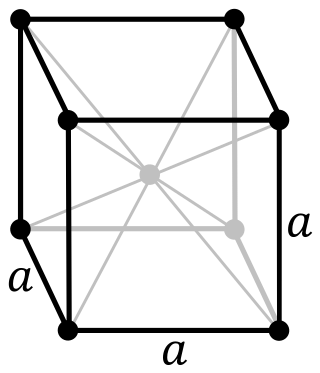
Seaborgium is a synthetic chemical element; it has symbol Sg and atomic number 106. It is named after the American nuclear chemist Glenn T. Seaborg. As a synthetic element, it can be created in a laboratory but is not found in nature. It is also radioactive; the most stable known isotope, 269Sg, has a half-life of approximately 14 minutes.
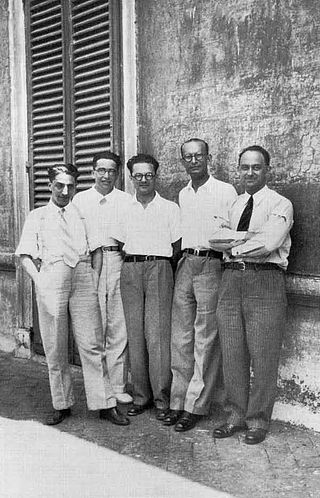
Franco Dino Rasetti was an Italian physicist, paleontologist and botanist. Together with Enrico Fermi, he discovered key processes leading to nuclear fission. Rasetti refused to work on the Manhattan Project on moral grounds.

Otto Hahn was a German chemist who was a pioneer in the fields of radioactivity and radiochemistry. He is referred to as the father of nuclear chemistry and father of nuclear fission. Hahn and Lise Meitner discovered radioactive isotopes of radium, thorium, protactinium and uranium. He also discovered the phenomena of atomic recoil and nuclear isomerism, and pioneered rubidium–strontium dating. In 1938, Hahn, Lise Meitner and Fritz Strassmann discovered nuclear fission, for which Hahn received the 1944 Nobel Prize for Chemistry. Nuclear fission was the basis for nuclear reactors and nuclear weapons.

Oganesson is a synthetic chemical element; it has symbol Og and atomic number 118. It was first synthesized in 2002 at the Joint Institute for Nuclear Research (JINR) in Dubna, near Moscow, Russia, by a joint team of Russian and American scientists. In December 2015, it was recognized as one of four new elements by the Joint Working Party of the international scientific bodies IUPAC and IUPAP. It was formally named on 28 November 2016. The name honors the nuclear physicist Yuri Oganessian, who played a leading role in the discovery of the heaviest elements in the periodic table. It is one of only two elements named after a person who was alive at the time of naming, the other being seaborgium, and the only element whose eponym is alive as of 2024.

Emilio Gino Segrè was an Italian and naturalized-American physicist and Nobel laureate, who discovered the elements technetium and astatine, and the antiproton, a subatomic antiparticle, for which he was awarded the Nobel Prize in Physics in 1959 along with Owen Chamberlain.

Via Panisperna boys is the name given to a group of young Italian scientists led by Enrico Fermi, who worked at the Royal Physics Institute of the University of Rome La Sapienza. In 1934 they made the famous discovery of slow neutrons, which later made possible the nuclear reactor and then the construction of the first atomic bomb.
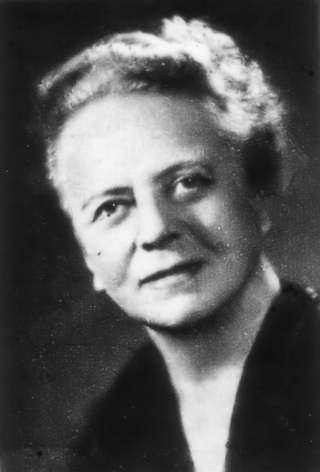
Ida Noddack, néeTacke, was a German chemist and physicist. In 1934 she was the first to mention the idea later named nuclear fission. With her husband Walter Noddack, and Otto Berg, she discovered element 75, rhenium. She was nominated three times for the Nobel Prize in Chemistry.
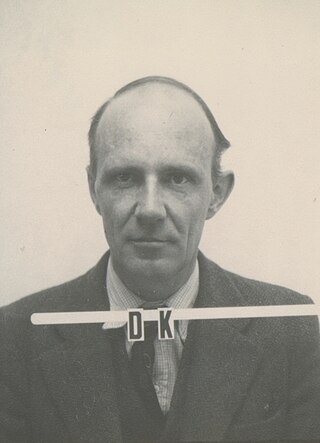
Egon Bretscher was a Swiss-born British chemist and nuclear physicist and Head of the Nuclear Physics Division from 1948 to 1966 at the Atomic Energy Research Establishment, also known as Harwell Laboratory, in Harwell, United Kingdom. He was one of the pioneers in nuclear fission research and one of the first to foresee that plutonium could be used as an energy source. His work on nuclear physics led to his involvement in the British atomic bomb research project Tube Alloys and his membership of the British Mission to the Manhattan Project at Los Alamos, where he worked in Enrico Fermi's Advanced Development Division in the F-3 Super Experimentation group. His contributions up to 1945 are discussed by Margaret Gowing in her "Britain and Atomic Energy, 1935-1945."

Herbert Lawrence Anderson was an American nuclear physicist who was Professor of Physics at the University of Chicago.
Eugene Theodore Booth, Jr. was an American nuclear physicist. He was a member of the historic Columbia University team which made the first demonstration of nuclear fission in the United States. During the Manhattan Project, he worked on gaseous diffusion for isotope separation. He was the director of the design, construction, and operation project for the 385-Mev synchrocyclotron at the Nevis Laboratories, the scientific director of the SCALANT Research Center, and dean of graduate studies at Stevens Institute of Technology. Booth was the scientific director of the SCALANT Research Center, in Italy.

Oscar D'Agostino was an Italian chemist and one of the so-called Via Panisperna boys, the group of young scientists led by Enrico Fermi: all of them were physicists, except for D'Agostino, who was a chemist.
Bohemium was the name assigned to the element with atomic number 93, now known as neptunium, when its discovery was first incorrectly alleged. It was named after Bohemia.
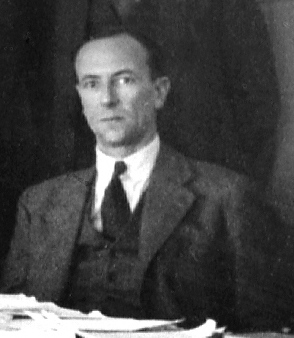
The discovery of the neutron and its properties was central to the extraordinary developments in atomic physics in the first half of the 20th century. Early in the century, Ernest Rutherford developed a crude model of the atom, based on the gold foil experiment of Hans Geiger and Ernest Marsden. In this model, atoms had their mass and positive electric charge concentrated in a very small nucleus. By 1920, isotopes of chemical elements had been discovered, the atomic masses had been determined to be (approximately) integer multiples of the mass of the hydrogen atom, and the atomic number had been identified as the charge on the nucleus. Throughout the 1920s, the nucleus was viewed as composed of combinations of protons and electrons, the two elementary particles known at the time, but that model presented several experimental and theoretical contradictions.

Nuclear fission was discovered in December 1938 by chemists Otto Hahn and Fritz Strassmann and physicists Lise Meitner and Otto Robert Frisch. Fission is a nuclear reaction or radioactive decay process in which the nucleus of an atom splits into two or more smaller, lighter nuclei and often other particles. The fission process often produces gamma rays and releases a very large amount of energy, even by the energetic standards of radioactive decay. Scientists already knew about alpha decay and beta decay, but fission assumed great importance because the discovery that a nuclear chain reaction was possible led to the development of nuclear power and nuclear weapons. Hahn was awarded the 1944 Nobel Prize in Chemistry for the discovery of nuclear fission.
References
- 1 2 3 Sime, Ruth Lewin (2000). "The Search for Transuranium Elements and the Discovery of Nuclear Fission". Physics in Perspective. 2 (1): 48–62. Bibcode:2000PhP.....2...48S. doi:10.1007/s000160050036. S2CID 117751813.
- ↑ Noddack, Ida (1934). "Über das Element 93". Angewandte Chemie. 47 (37): 653–655. Bibcode:1934AngCh..47..653N. doi:10.1002/ange.19340473707.
- ↑ Fermi, E. (1934). "Possible Production of Elements of Atomic Number Higher than 92". Nature. 133 (3372): 898–899. Bibcode:1934Natur.133..898F. doi: 10.1038/133898a0 .